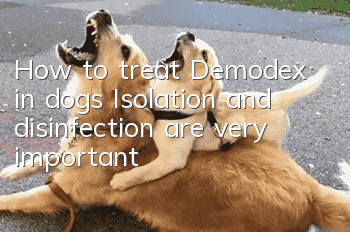How to treat Demodex in dogs? Isolation and disinfection are very important

Treatment measures for Demodex in dogs
1. Isolate and treat sick dogs, and use acaricides to disinfect contaminated places and utensils.2. In addition to local application of insecticides to severely ill dogs, antibacterial drugs should also be applied systemically to prevent secondary infections.
3. For scaly type, you should first scrub the affected area with a mixture of alcohol or ether, or scrape it clean so that the drug can reach the hair follicles. The medication is as follows: 25% or 50% benzyl benzoate emulsion, fully rub the affected area, infiltrate with 5% formalin solution for 5 minutes, once every 3 days, a total of 5-6 times.
4. For pustular type, first cut the pustule, wash it with 3% hydrogen peroxide solution, rub it with 3% iodine tincture or 3% gentian violet solution, and then treat the scales.
5. In addition to parasitizing the skin and subcutaneous connective tissue, Demodex mites can It can also parasitize in lymph nodes, so when treating pustular type, both local therapy and chemotherapy (intravenous injection of trypan blue or intramuscular injection of trypanaxanthin, etc.) must be used, supplemented by high-dose penicillin therapy.
Causes of Demodicosis in Dogs
1. Canine Demodex is translucent and milky white, with a long and narrow body like a worm, with a body length of 0.25-0.3 mm and a width of about 0.04 mm. It can be divided into three parts: front, middle and rear.2. The entire development process of Demodex canis occurs on the dog body, including 4 stages: egg, larvae, nymph, and adult, of which nymph has 3 stages.
3. Canine Demodex mostly parasitizes in the upper part of the hair follicles of the affected skin, and then moves to the bottom, and rarely parasitizes in the sebaceous glands. In addition, in addition to parasitizing hair follicles, they can also live in dog tissues and lymph nodes, and some of them reproduce in them.
Symptoms of dog demodicosis
1. Scaly type: mostly occurs in and around the eyelids, corners of the mouth, forehead, nose, lower part of the neck, elbows, between toes, etc. . The affected area is hairless, accompanied by mild flushing of the skin and the production of silvery white sticky scurf. The skin appears slightly rough and cracked, or has small nodules. Later, the skin turns blue-gray white or red copper, and the affected area is almost not itchy, and some remain unchanged for a long time. Some turn into pustular type.2. Pustular type: mostly occurs in the neck, chest, inner thigh and other parts, and later spreads to the whole body. Dogs have large areas of hair loss, large red spots, and thick skin that often forms wrinkles. Pustules that are as big as millet to wheat grains. The pustules are blue-red and discharge pus when squeezed. They contain a large number of Demodex mites and insect eggs. After the pustules rupture, they will form ulcers, become inflamed, and have an unpleasant stench. The pustular type also has almost no itching. If there is severe itching, it may be a mixed infection. Eventually death may occur from exhaustion, poisoning, or sepsis.
Random articles
- What do dogs eat to protect their stomach? It is important to protect their stomach and treat gastrointestinal diseases in dogs.
- How to tell if your dog is fat? Is your dog overweight?
- Will your dog catch a cold if you blow the air conditioner? What should you do if your dog catches a cold if you blow the air conditioner?
- What should you pay attention to when your dog drinks water? Don’t be careless when it comes to your dog’s drinking water.
- The dog's mouth bites and shakes. Why does the dog's mouth occasionally shake and bite?
- How to cut a dog's hair? Do you know how to cut a dog's hair correctly?
- Can dogs eat raw eggs? Why can’t dogs eat egg whites?
- Common Dog Problems in Summer How to Deal with Different Dog Problems
- How to keep dogs away from skin diseases. If you do this, will you see if your dog will still be infected with skin diseases?
- What causes anorexia in dogs? Dogs will become anorexic due to lack of exercise. Hounds run at least 5KM every day.



